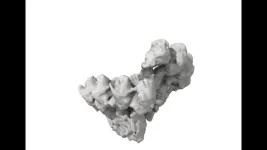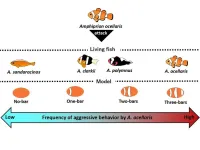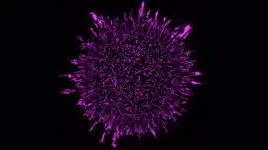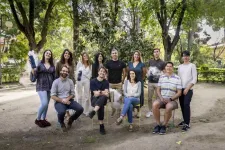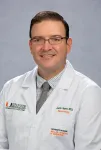(Press-News.org) Researchers at the Centre for Genomic Regulation (CRG) in Barcelona and the Spanish National Cancer Research Centre (CNIO) in Madrid have captured the world’s first high-resolution images of the earliest moments of microtubule formation inside human cells. The findings, published today in the journal Science, lay the foundations for potential breakthroughs in treating many different types of diseases ranging from cancer to neurodevelopmental disorders.
“Microtubules are critical components of cells, but all the images we see in textbooks describing the first moments of their creation are models or cartoons based on structures in yeast. Here we capture the process in action inside human cells. Now that we know what it looks like, we can explore how it’s regulated. Given the fundamental role of microtubules in cell biology, this could eventually lead to new therapeutic approaches for a wide range of disorders,” explains ICREA Research Professor Thomas Surrey, main co-author of the study and researcher at the Centre for Genomic Regulation.
Molecular ‘highways’ of the cell
A cell is much like a bustling city, requiring state-of-the-art infrastructure to function. One of the most important components are microtubules, tubes made of proteins which act like bridges or roads that help move things around and give the cell its shape. Importantly, they are critical for cell division, ensuring that two new cells can be born from a parent cell. In neurons, they are absolutely essential, forming highways for transport over long distances.
Microtubules are built by a large assembly of proteins known as the gamma-tubulin ring complex (γ-TuRC). The proteins work like a blueprint, laying down tiny building blocks called tubulins in a specific order. This is a process called microtubule nucleation, which is like laying the foundation stones of a bridge. Once the foundation is set, tubulins are added to make the bridge as long as necessary.
For the cell to work correctly, microtubules need to be made of thirteen different rows of tubulins. A few years ago, researchers were baffled to discover that human γ-TuRC exposes fourteen rows of tubulins. This was confusing because researchers expected it to be a perfect template for microtubules, which did not seem to be the case. But high-resolution structures had only been pictured of either γ-TuRC or microtubules in isolation and never together – until now.
“We had to find conditions that allowed us to image over a million microtubules in the process of nucleation before they grow too long and obscure the action of γ-TuRC. We were able to achieve this using the molecular toolbox of our lab and then freeze the microtubule stubs in place", explains Cláudia Brito, postdoctoral researcher at the CRG and co-first author of the study.
High-resolution imaging
To observe γ-TuRC while it was actively forming microtubules, researchers prepared samples at the CRG in Barcelona and the Electronic Microscopy Center at ALBA (EMCA), where they were flash-frozen in a thin layer of ice – preserving the natural shape of the molecules involved and helping discern fine details of structures at near atomic level. Frozen samples were then sent to the Basque Resource for Electron Microscopy (BREM) in Vizcaya, where the high-resolution data generated was then transferred to be analysed at the CNIO in Madrid. Marina Serna, Staff Scientist at CNIO and co-first author of the study, used the images obtained by cryo-electron microscopy and complex image processing methods to determine the 3D structure of γ-TuRC while forming microtubules.
This analysis revealed that as γ-TuRC starts the nucleation process and as the microtubule begins to form, it cleverly changes its shape. Initially in an open state, it progressively closes as the microtubule grows. The change makes γ-TuRC stow away one of its 14 tubulins, effectively matching the design of the microtubule that needs only 13 rows. The whole process is facilitated by a newly-discovered latch mechanism, revealing that it’s the growing microtubule itself which helps the template find its correct shape.
Oscar Llorca, Director of the Structural Biology program at CNIO and main co-author of the paper, explains: "We have visualized the process that initiates microtubule formation, and we see that human γ-TuRC is an open ring that closes to effectively become a perfect template to nucleate microtubules. But we also discovered that this ring, in order to close, needs the 'first brick' of a microtubule to be put in place; when this happens, a region of the human γ-TuRC acts as an anchor that engages this 'first brick' to then close the ring and launch the formation of the microtubules".
Implications for human health and disease
The most well-known consequence of microtubule malfunction is cancer, a disease characterised by uncontrolled cell proliferation. Neurodevelopmental disorders such as microcephaly also occur when microtubule processes go wrong, as well as other conditions ranging from respiratory problems to heart disease.
Some cancer drugs work by targeting microtubules, preventing them from disassembling or forming in the first place. However, these disrupt microtubules indiscriminately in both cancerous and healthy cells, leading to side effects. Tumours also develop resistance to these drugs.
The findings of the study are important because understanding the precise mechanism of how microtubules are laid down could lead to the development of more targeted and effective cancer treatments, as well as new therapies for a broader range of conditions.
“The process of nucleation decides where the microtubules are in a cell and how many you have in the first place. It is likely that the conformational changes we observe are controlled by yet-to-be-found regulators in cells. Several candidates have been described in other studies, but their mechanism of action is unclear. As further work clarifies how regulators bind to γ-TuRC and how they affect the conformational changes during nucleation, it may transform our understanding of how microtubules work, and eventually offer alternative sites that one might want to target to prevent cancer cells from going through the cell cycle,” concludes Dr. Surrey.
END
Human cells building ‘molecular highways’ captured for first time
Researchers have imaged microtubule formation in unprecedented detail, laying the foundation for future therapies
2024-02-01
ELSE PRESS RELEASES FROM THIS DATE:
Clown anemonefish seem to be counting bars and laying down the law
2024-02-01
We often think of fish as carefree swimmers in the ocean, reacting to the world around them without much forethought. However, new research from the Okinawa Institute of Science and Technology (OIST) suggests that our marine cousins may be more cognizant than we credit them for.
By observing how a colony of clown anemonefish (Amphiprion ocellaris) – the species of the titular character in Finding Nemo – reacts to intruders in their sea anemone home, OIST researchers have found that ...
New research shows that the arrangement of bacteria in biofilms affects their sensitivity to antibiotics
2024-02-01
Bacteria are traditionally imagined as single-cell organisms, spread out sparsely over surfaces or suspended in liquids, but in many environments the true bacterial mode of growth is in sticky clusters called biofilms. Biofilm formation can be useful to humans—it is integral, for example, to the production of kombucha tea. But it is more often problematic, because it makes it more difficult to control bacterial growth: When bacterial cells produce a biofilm, it acts as a shield against outside invaders, making the bacteria more ...
First atomic-scale 'movie' of microtubules under construction, a key process for cell division
2024-02-01
· Researchers at the Centre for Genomic Regulation (CRG) , the Spanish National Cancer Research Center (CNIO) and the IBMB-CSIC solve a key problem in biology: how human cells build their microtubules
· During cell division, microtubules function as nanometer-thick long ‘ropes' inside cells that pull chromosomes apart so that each daughter cell receives a copy of the genetic material
· The work published in Science lays the groundwork for future breakthroughs in the treatment of diseases ranging from cancer to neurodevelopmental disorders
Cells in the human body are constantly dividing. With each division the genetic information contained in the ...
Mapping the structure and organization of hippocampal neurons in the mouse brain
2024-02-01
Single-cell projectome analysis has revealed previously unknown spatial organization principles of the brain-wide structure and connectivity of more than 10,000 individual hippocampal neurons in the mouse brain, according to a new study. Specialized projections called axons allow neurons to transmit signals to other neurons across the brain. The hippocampus (HIP) – one of the most extensively studied brain regions – plays a crucial role in many crucial brain functions, including learning, memory, ...
Large herbivores’ effects on ecosystems depend more on size and diet than on herbivore origin
2024-02-01
The effect of large herbivores on plant abundance and diversity depends more on their size and diet than whether they are native or introduced into their host ecosystems, according to a meta-analysis of more than 200 studies worldwide. The findings counter the widely held notion that the impacts of introduced megafauna are distinct and more harmful than those of native megafauna and suggest that trait-based ecology provides better insight into megaherbivore-plant interactions than concepts of species origin. Large mammal herbivores play a key role in shaping ecosystems and biodiversity by consuming vegetation, dispersing seeds and nutrients, and creating ...
The evolution of sign languages globally revealed through computational analyses
2024-02-01
A computational analysis has highlighted the poorly understood relationships and elusive histories of modern sign languages worldwide, revealing two major sign language families shaped by geopolitical forces and relevant signing communities. The findings show that the computational methods applied – which have been useful in understanding spoken languages – can be extended to the study of sign languages; as such, they offer promise for addressing the disparities in our understanding of other marginalized and diverse ...
AI system reveals new insights into early language acquisition through the experience of a single child
2024-02-01
A new machine learning model – trained on video and audio recorded from the first-person perspective of one young child for over a year – has provided new insights into early language acquisition. Not only do the findings offer a valuable framework to understand how children learn words and concepts, but they could be critical in developing artificial intelligence (AI) systems that can learn language in more human-like ways. Beginning around 6 to 9 months of age, children begin acquiring their ...
Targeting treatment resistance in chronic lymphocytic leukemia
2024-02-01
MIAMI, FLORIDA (EMBARGOED UNTIL FEB. 1, 2024, AT 2 P.M. ET) – New research from Sylvester Comprehensive Cancer Center at the University of Miami Miller School of Medicine and collaborating organizations has identified a next-generation BTK degrader that could help overcome treatment resistance in chronic lymphocytic leukemia (CLL) and related blood cancers.
Their findings, published Feb. 2 in the journal Science, could offer a therapeutic option for CLL patients whose tumors become drug-resistant or are unresponsive to frontline treatment.
“This new compound not only inhibits the cellular molecule BTK, but goes further by taking aim at the target ...
Sustainable carbon removals limits identified, huge climate mitigation challenge revealed
2024-02-01
*Embargoed until 14:00 US Eastern / 19:00 UK GMT / 20:00 Europe CET – Thursday 1 February*
Governments and businesses are relying on dangerous amounts of future removal of carbon dioxide (CO2) from the atmosphere, instead of more rapidly reducing emissions and phasing out fossil fuels. This problem is partly due to an incomplete picture1 of the damaging consequences of carbon dioxide removal for people, food security and natural ecosystems, according to new research published in Science.
The paper finds that the carbon dioxide removal potential currently reported by the UN ...
Whole-brain projection patterns of single neurons in mouse hippocampus unveiled
2024-02-01
A study published in Science on Feb. 1 reported a comprehensive database of single-neuron projectomes consisting of over 10,000 mouse hippocampal neurons, thus revealing the spatial connectivity patterns of mouse hippocampal neurons at the mesoscopic level.
The study was conducted by teams from the Center for Excellence in Brain Science and Intelligence Technology (CEBSIT), the Institute of Neuroscience of the Chinese Academy of Sciences (CAS), the HUST-Suzhou Institute for Brainsmatics, Hainan University, the Kunming Institute of Zoology of CAS, Lingang Laboratory, and the Shanghai Center for ...
LAST 30 PRESS RELEASES:
New expert guidance urges caution before surgery for patients with treatment-resistant constipation
Solar hydrogen can now be produced efficiently without the scarce metal platinum
Sleeping in on weekends may help boost teens’ mental health
Study: Teens use cellphones for an hour a day at school
After more than two years of war, Palestinian children are hungry, denied education and “like the living dead”
The untold story of life with Prader-Willi syndrome - according to the siblings who live it
How the parasite that ‘gave up sex’ found more hosts – and why its victory won’t last
When is it time to jump? The boiling frog problem of AI use in physics education
Twitter data reveals partisan divide in understanding why pollen season's getting worse
AI is quick but risky for updating old software
Revolutionizing biosecurity: new multi-omics framework to transform invasive species management
From ancient herb to modern medicine: new review unveils the multi-targeted healing potential of Borago officinalis
Building a global scientific community: Biological Diversity Journal announces dual recruitment of Editorial Board and Youth Editorial Board members
Microbes that break down antibiotics help protect ecosystems under drug pollution
Smart biochar that remembers pollutants offers a new way to clean water and recycle biomass
Rice genes matter more than domestication in shaping plant microbiomes
Ticking time bomb: Some farmers report as many as 70 tick encounters over a 6-month period
Turning garden and crop waste into plastics
Scientists discover ‘platypus galaxies’ in the early universe
Seeing thyroid cancer in a new light: when AI meets label-free imaging in the operating room
Neutrophil-to-lymphocyte ratio may aid risk stratification in depressive disorder
2026 Seismological Society of America Annual Meeting
AI-powered ECG analysis offers promising path for early detection of chronic obstructive pulmonary disease, says Mount Sinai researchers
GIMM uncovers flaws in lab-grown heart cells and paves the way for improved treatments
Cracking the evolutionary code of sleep
Medications could help the aging brain cope with surgery, memory impairment
Back pain linked to worse sleep years later in men over 65, according to study
CDC urges ‘shared decision-making’ on some childhood vaccines; many unclear about what that means
New research finds that an ‘equal treatment’ approach to economic opportunity advertising can backfire
Researchers create shape-shifting, self-navigating microparticles
[Press-News.org] Human cells building ‘molecular highways’ captured for first timeResearchers have imaged microtubule formation in unprecedented detail, laying the foundation for future therapies
